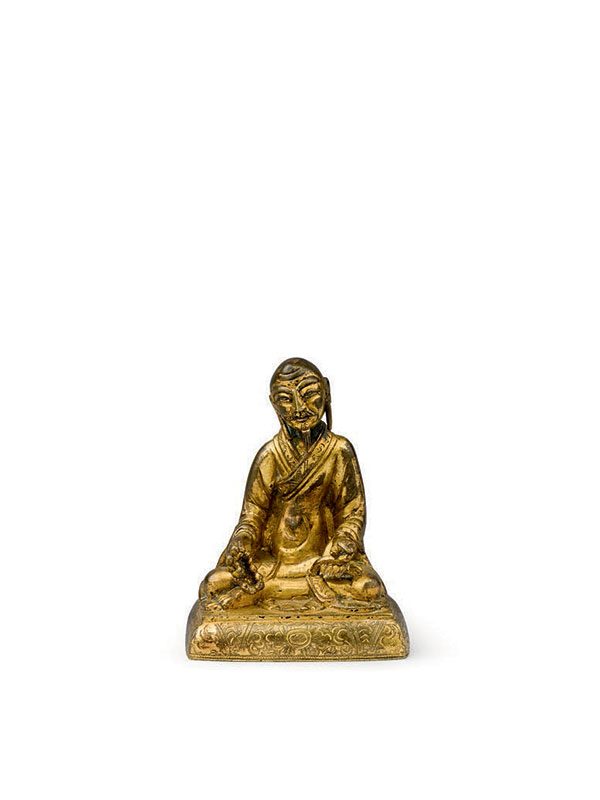Gilt bronze miniature figure of a seated luohan
A gilt bronze figure of a luohan, seated upon a rectangular throne cushion. He is depicted with his legs crossed, his upper body slightly inclined towards the left. He wears a fitted robe, which is draped down and pleated around his legs. His hands rest on his knees. He holds a ruyi sceptre in his left hand and a rosary in his right hand. The luohan’s demure face is carved in detail, showing his moustaches and wispy beard. The sides of the cushion are engraved with floral patterns resembling the texture of textiles. The bronze has several layers of gilding, with some areas showing a darker patina.
This finely cast and gilded bronze figure represents one of the Sixteen Great Luohans, also known as arhats in Sanskrit, who were considered to be the Elders of Buddhism and students of the historical Buddha Shakyamuni. Over time, the number of luohans increased from the original sixteen, as recorded in a book written approximately 800 years after the Buddha’s death by the Singhalese priest Nardimitar, to five hundred.[1] This bronze figure likely depicts the Fifth Luohan, Nakula Arhat. Although there is no inscription to aid the identification, a rubbing of Nakula Arhat originally from Shengyin Temple has closely comparable features and also holds a rosary in his right hand. This rubbing has inscriptions written by Emperor Qianlong (1736 – 1795) and is now in the collection of the Harvard Fine Arts Library.[2] A comparable gilt bronze figure of Guandi seated on a throne, of similar size and dated to the 18th century, is illustrated in Chinese and Japanese Bronzes, A.D. 1100 -1900.[3]
1 Welch, P. B. Chinese Art- A Guide to Motifs and Visual Imagery, Tuttle Publishing, 2012, p. 197
2 The Harvard Fine Arts Library online collection archive, special collections; F-48
3 Hausmann, U. Chinese and Japanese Bronzes, A.D. 1100-1900, London, 1989, no. 15C
鎏金銅羅漢
清 十八世紀
高:6 公分 寬:4.8 公分
小型鎏金銅羅漢像,結跏趺坐於卡墊上,上身微向右傾,身著袈裟,雙手垂於膝上,左手握持如 意把件,右手環握法珠。羅漢面容泰然,長鬚飄逸。衣領與卡墊處鏨刻出仿紡織品的紋飾。羅 漢是梵文Arhat的音譯「阿羅漢」之簡稱,又譯為“應真”,或又稱“尊者”,是釋迦牟尼的弟 子。羅漢像最初是依照佛教經典所造,侍立在釋迦兩側的比丘(和尚)像,即阿難、迦葉。後又 創造出十六、十八和五百羅漢像。雖本像無刻款提名,但依其型態與握持,可能為第五尊「諾距 羅尊者」,又名「靜坐羅漢」。哈佛大學燕京圖書館中現存清乾隆聖因寺十六尊者拓片,其中第 五尊者之像與本品相似,亦由右手握持法珠。

